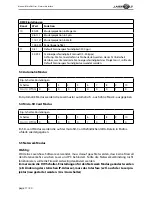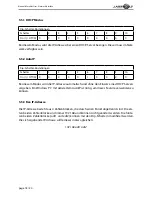
Manual: MicroNet Slim - Network Interface
page 6 / 20
Function overview:
- X/Y scanner output with 12 bit resolution (4096 different positions on each axis)
- Up to 6 color output with 8 bit resolution (256 different values per
color channels): red, green, blue, intensity, user defined 1, user defined 2
- DMX512 input and output (non-isolated)
- 10/100 Mbit Ethernet port
- Flexible IP address setting: fixed address, DHCP, or AutoIP
- Micro-SD card slot for ILDA file playback (ILDA format code 5 RGB)
- Build-in laser frames for standalone operation
- Standalone operation via audio control (with external microphone), DMX control, or auto
trigger
- maximum scan speed of up to 150kpps
- Up to 16 devices can be used in parallel for multi-projector laser shows
The DIP switches can be used to select the desired operating mode. The mode should be set
before switching on the device. Changing the mode while the device is active can lead to un-
defined and dangerous laser output.
In the stand-alone modes (audio controlled, DMX controlled, demo mode), the ILDA interface
displays pre-defined laser frame patterns. If there is no Micro-SD card present, the internal
patterns are used. Alternatively, a Micro-SD card with the preset ILDA files can be inserted.
The ILDA files have to use format code 5 (ILDA RGB file format). The file name has to consist
of a 3-digit number, followed by the extension .ild
Maximum number of files is 256.
Counting starts from 000.ild, followed by 001.ild, 002.ild... 255.ild
ILDA files are played at a speed of 50 frames per second.
Due to the huge mass of available Micro-SD cards on the market, it cannot be guaranteed
that all cards are compatible with the ILDA interface. The usage of small <=2GB SD cards
instead of high capacity SDHC or XDHC cards is recommended.
5.1 Sound-to-light Mode
Dip switch setting
switch
1
2
3
4
5
6
7
8
9
10
On (1) / Off (0) 0
0
0
0
0
0
0
0
1
0
5. Operation
Use the volume regulator of the projector to adjust audio sensitivity.
Tap the microphone to trigger audio control.
The upper LED flashes whenever an audio signal is detected. When the LED is permanently
on, audio sensitivity should be reduced.






































